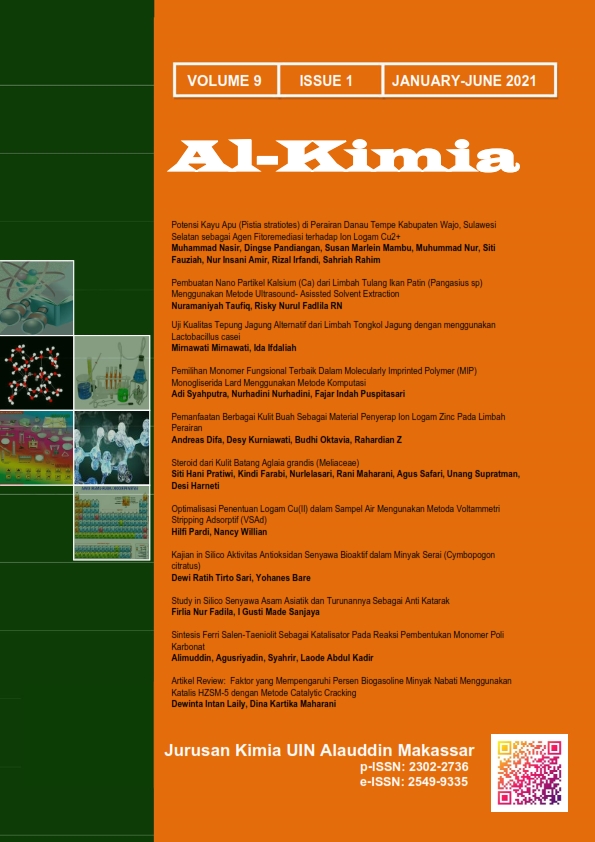Sintesis Ferri Salen-Taeniolit Sebagai Katalisator Pada Reaksi Pembentukan Monomer Poli Karbonat
Abstract
The researcher has succeeded in synthesizing the Ferri Salen-Taenolite complex as a clay based catalyst and applying it to the reaction of glycerol carbonate formation. Lewis acidity of the catalyst complex can increase through the immobilization process in addition, the activity and selectivity of the catalyst also increase. The formation of salene ligands is shown by the appearance of the peak C=N at the wave number around 1640 cm-1 and the O-H peak around 3400 cm-1. The formation of the Fe(salen)NO3 complex is indicated by the reduction of the vibration intensity O-H at the wave number of about 3400 cm-1 and the shift of the peak C=N in the area around 1640 cm-1 to 1690 cm-1. The complex [Fe(salen)]NO3 has been synthesized with physical properties in the form of brown powder and effective magnetic moment by 2,197 BM. The complex [Fe(salen)] + was successfully immobilized into the LiTN as much as 9.12 mmol/g LiTN. Based on the catalytic activity test, the catalyst was active in the reaction of polycarbonate monomer formation which is indicated by a change in vibration of the urea carbonyl (CO amine) group at wave number 4242 cm-1 to vibrate the carbonyl group (CO ester) at wave number 1786 cm-1 which indicates that glycerol carbonate has been formed.
Downloads
References
Bai, C., Xiao, W., Feng, D., Xian, M., Guo, D., Ge, Z. & Zhou, Y. 2013, "Efficient decolorization of Malachite Green in the Fenton reaction catalyzed by [Fe(III)-salen]Cl complex", Chemical Engineering Journal, vol. 215-216, pp. 227-234.
Casiello M, Monopoli A,Cotugno P, 2014, Copper(II) chloride-catalyzed oxidative carbonylation of glycerol to glycerol carbonate[J], Journal of Molecular Catalysis A:Chemical, 381:99-106.
Hammond,C., Lopez-Sanchez, J.A., Ab Rahim, M.H., Dimitratos, N., Jenkins, R.L., Carley, A.F., He, Q., Kiely, C.J., Knight, D.W., Hutchings, G.J., 2011, Synthesis of glycerol carbonate from glycerol and urea with gold-based catalysts. Dalton Trans. 40, 3927–37.
Khabazzadeh, H., Sheikhshoaie, I., Sotideh, N., 2013, “[Fe(III)(Salen)Cl] Complex as a Catalyst for the Synthesis of 1,8-dioxo-octahydroxanthene Derivatives”, Journal of Sciences, Islamic Republic of Iran, vol. 24, no. 2, pp. 123-127.
Permana, Y., Ichikuni, N. & Shimazu, S. 2012, "Ring-opening of oxiranes using Taeniolite-supported tris(β-diketonato)zirconium", ITB Journal of Science, vol. 44 A, no. 3, pp. 263-274.
Permana, Y., Shimazu, S., Ichikuni, N. & Uematsu, T., 2004, Selective Synthesis of Primary Methoxypropanol Using Clay Supported Tris(2,4 pentanedionato) zirconium(IV), J. Mol. Catal. A-Chem., 221, pp. 141-144,
Routler, S., Vezin, H., Lamour, E., Bernier, J., Catteau, J. & Bailly, C. 1999, “DNA cleavage by hydroxyl-salicylidene-ethylenediamine-iron complex”. Nuclei Acids Research, vol. 27, no. 21, pp. 4160-4166.
Suzuki, N., Yamamoto, D., Anaguchi, N., Tsuchiya, H., Aoki, K. & Kanzaki, Y., 2000, The Ion-Exchange Property of Some Layered Inorganic Materials with Potassium Ion, Rubidium Ion and Cesium Ion, and Selective Cesium Ion-Exchange of Synthetic Mica, Bull. Chem. Soc. Jpn, 73, pp. 2599-2603.
Suzuki, N., Itoh, M., Igarashi, M. & Kanzaki, Y., 2003, Solid NMR Study of the Ion-Exchange Properties on ɣ-Titanium Phosphate with Alkali Metal Ions, J. Ion Exchange, 14, pp. 169-172.
Turney, T. W., Patti, A., Gates, W., Shaheen, U. & Kulasegaram, S., 2013, Formation of glycerol carbonate from glycerol and urea catalysed by metal monoglycerolates. Green Chem. 15, 1925.
Copyright (c) 2021 Laode Abdul Kadir

This work is licensed under a Creative Commons Attribution-NonCommercial-ShareAlike 4.0 International License.
Authors who publish with this journal agree to the following terms:
1) Authors retain copyright and grant the journal right of first publication with the work simultaneously licensed under a Creative Commons Attribution License that allows others to share the work with an acknowledgement of the work's authorship and initial publication in this journal.
2) Authors are able to enter into separate, additional contractual arrangements for the non-exclusive distribution of the journal's published version of the work (e.g., post it to an institutional repository or publish it in a book), with an acknowledgement of its initial publication in this journal.
3)Authors are permitted and encouraged to post their work online (e.g., in institutional repositories or on their website) prior to and during the submission process, as it can lead to productive exchanges, as well as earlier and greater citation of published work (See The Effect of Open Access).


